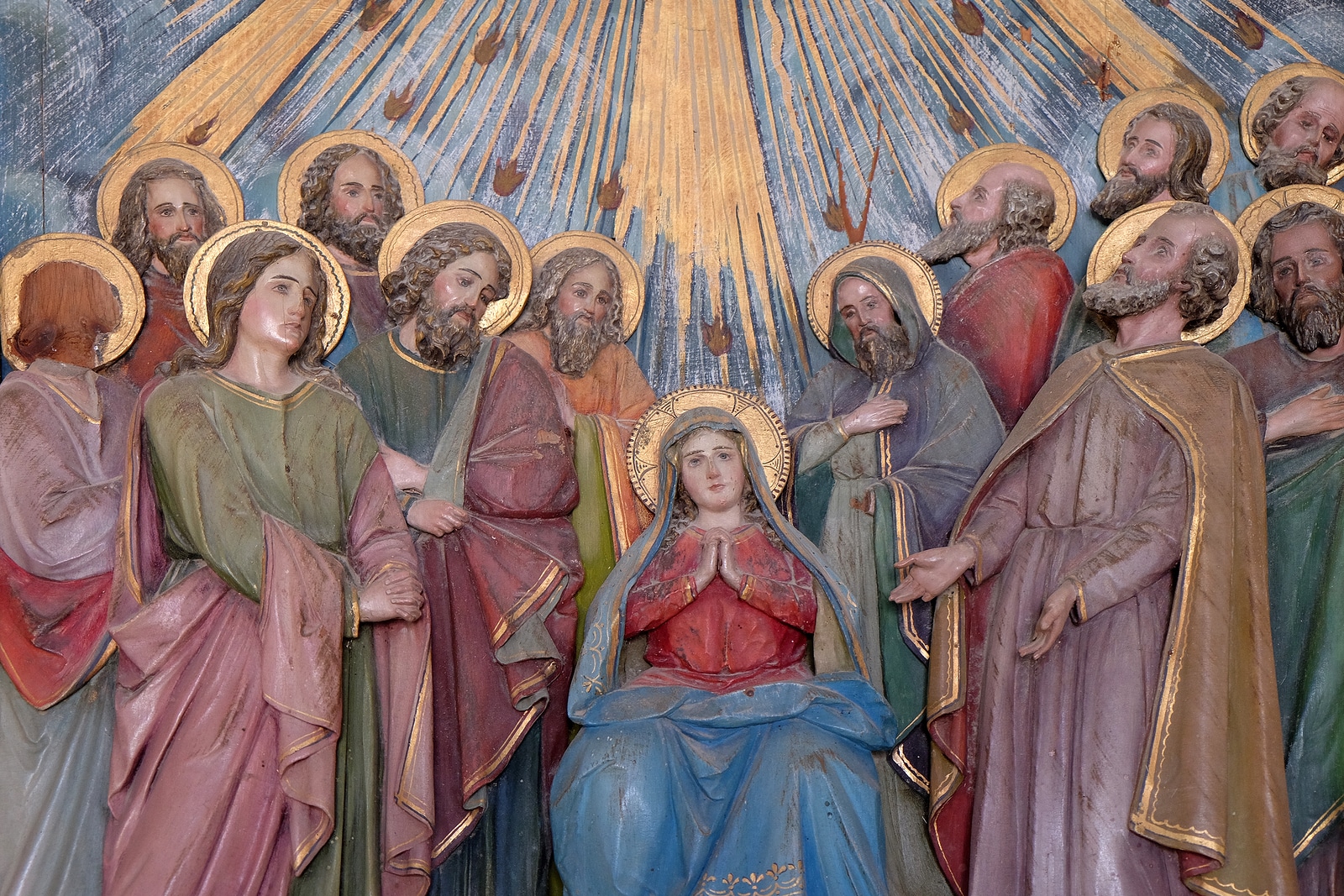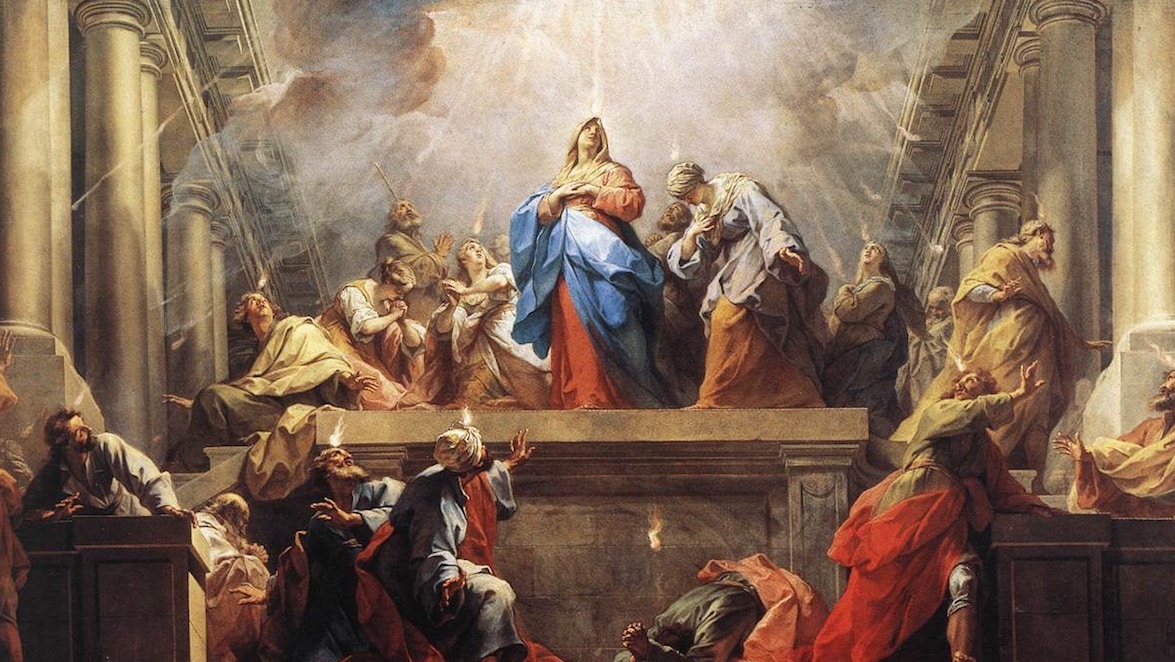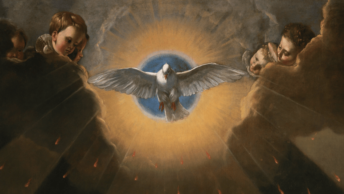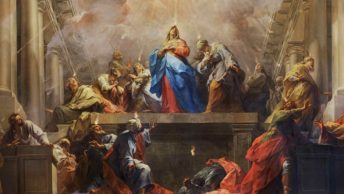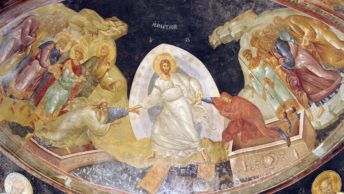Pentecost is a meta-historical event. It transcends our world of time and space. It opens our world to eternal reality. It helps us go into the hub of reality: the Holy Spirit’s presence in the Church. In this sense, the icon of the Pentecost is a representation of the Church.
This fabulous icon reminds us of that most singular event which we find recounted in the Book of Acts 2:1-4. When the day of Pentecost had come, they were all together in one place. And suddenly a sound came from heaven like the rush of a mighty wind, and it filled all the house where they were sitting. And there appeared to them tongues as of fire, distributed and resting on each one of them. And they were all filled with the Holy Spirit and began to speak in other tongues, as the Spirit gave them utterance. The icon portrays this magnificent event which the Book of Acts has already talked about. The Holy Spirit descended as tongues of fire upon the Apostles when these were gathered together. And He descended on them to empower them to preach Him in various languages. In a nutshell, the prophecy Jesus foretold in chapter 1 of the Book of Acts, namely that: You shall receive power when the Holy Spirit has come upon you; and you shall be my witnesses in Jerusalem and in all Judea and Sama’ria and to the end of the earth (Acts 1:8) really came true!
![]() The Pentecost icon gives us an excellent catechesis on the nature of the Church. The Church, which is hierarchic in its very essence, is under the divine guidance of the Holy Spirit to convert the world. The Holy Spirit acts in and through the Church to bring his own order of the world, namely holiness! This is his core presence in the world.
The Pentecost icon gives us an excellent catechesis on the nature of the Church. The Church, which is hierarchic in its very essence, is under the divine guidance of the Holy Spirit to convert the world. The Holy Spirit acts in and through the Church to bring his own order of the world, namely holiness! This is his core presence in the world.
There are two iconographic traditions of the same Pentecost event. Starting from the Latin tradition, we find inserted in the icon the tongues of fire as well as the presence of the Holy Mother of God which are accentuated by the presence of the twelve apostles. On the other hand, within the Orthodox tradition, we do not always find the depiction of tongues of fire. Rather, we encounter at the top of the icon a circle or semicircle which shows heaven and from its centre there are twelve rays that head downward toward the twelve apostles, thus suggesting the descent of the Holy Spirit.
Furthermore, in the majority of Orthodox icons Mary, the Mother of God, is absent at the Pentecost event; even though, as the Acts of the Apostles rightly says, Mary was present. All these with one accord devoted themselves to prayer, together with the women and Mary the mother of Jesus, and with his brothers (Acts 1:14). But why is Mary absent from the Orthodox Pentecost icons? The reason is that such icons tend to accentuate more and more the basic ecclesiological meaning of Pentecost. These icons are not that much interested in the narrative details of the Holy Spirit’s descent or any noticeable physical facts as recounted to us in the Book of Acts.
The Pentecost icon brings to the fore the special role of God the Holy Spirit. The latter is the source of unity and harmony of the apostles which is symbolized in the semicircle at the icon’s top. From here rays of light shine down to enlighten them. There are times when the “tongues of fire,” described in Acts, are portrayed at the rays’ tips as they ready themselves to descend upon the awaiting apostoles. In other instances, we can also encounter the tongues of fire that are already present within the halos of each of the saints who are seated. Additionally, other icons also show a dove, either with the mandorla at the icon’s top or identically descending upon the apostles who are assembled in the upper room. Since the Holy Spirit appeared as a dove as Jesus was baptized, it is comprehensible that this same model of the Spirit is utilised as well in the Pentecost icons. Having said that, even if the Holy Spirit appeared as tongues of flame at Penetcost and a dove at Christ’s Baptism in actual fact He is neither a tongue of flame nor a dove. In this perspective, one can rightly appreciate why the Orthodox tradition refrains from depicting the Holy Spirit as a dove at Pentecost or in any icon save those which represent Our Lord’s Baptism.
![]() What can we say about the apostles? Let us start from what the Liturgy of St. John Chrysostom tells us in the Apolytikion (Dismissal Hymn is a troparion, that is a short hymn of one stanza) said or sung at Orthodox Christian worship services) for Pentecost: Blessed are You, O Christ our God, who made fishermen all-wise, by sending down upon them the Holy Spirit, and through them, drawing all the world into Your net. O Loving One, glory be to You.
What can we say about the apostles? Let us start from what the Liturgy of St. John Chrysostom tells us in the Apolytikion (Dismissal Hymn is a troparion, that is a short hymn of one stanza) said or sung at Orthodox Christian worship services) for Pentecost: Blessed are You, O Christ our God, who made fishermen all-wise, by sending down upon them the Holy Spirit, and through them, drawing all the world into Your net. O Loving One, glory be to You.
The icon offers us some interesting points regarding the apostles. First, they are seated in a semicircle mode to highlight their unity and harmony. Let us not forget that this semicircle is open towards us to include us in it. Do we not need the unity and harmony of the Holy Spirit? Second, there is a variety of contrasting poses in the figures of the apostles. What this means is that despite the fact that there is the one Spirit, who makes one Body, yet each individual member is endowed with special gifts. To stress this the Orthodox tradition highlights the inverse perspective: meaning that the figures’ size grow bigger as they get closer to the central seat. It prohibits the apostles who stand close to the back of the semicircle from being represented as smaller as it occurs in the execution of most normal paintings. In practice, this simply means that there is no apostle who is greater than another. They are all equal.
Since their teaching gift is greatly stressed the apostles appear holding scrolls. Moreover, the Eastern iconographic rendition of Pentecost is depicted as an orderly, calmly and most solemn event. The purpose behind such a representation is to portray the unity and singularity of purpose of the hierarchic Church in converting the world. This greatly contrasts with the Western rendition of Pentecost wherein there is a general sense of confusion.
The icon of Pentecost is driving home the message that it is mainly an image of the Church. For that matter the icon represents not just the twelve apostles who were present at this biblical extraordinary event. It also includes St Paul, St Luke and St Mark who were certainly not present at Pentecost. In fact, St Paul is sitting to the left of the principal seat whereas St Peter is sitting on the right. St Luke and St Mark, together with the Evangelists, are usually represented. When these are portrayed their presence excludes the other three apostles from the icon. This is done because the number twelve, the perfect number, has to be strictly kept. However, that change is not important here. Let us not forget that the icon’s significance is the solid presence of the Holy Spirit in the Church. However, the Western tradition is more legalistic in its iconic rendition of the event limiting exclusively itself to the twelve original apostles, adding of course St Matthias who took Judas’ place among the twelve.
A noticeable detail of the Orthodox icon of Pentecost is the empty space that is to be found at the central seat. The latter, also called the “Teacher’s Seat” is a place of honour around which the apostles are assembled. The reason why this seat is empty is because only Christ will be sitting in it. Christ is the one who physically went into Heaven. Christ cared for his own so much that he promised to send them the Holy Spirit as their comforter, advocate and guide. As a matter of fact, this promise initially was brought into completion at Pentecost and is still going on today. Hence, the icon, which is also an icon of the Church, portrays the apostles who are assembled in unity and supported by the Holy Spirit’s power. They are encircling Christ whose presence is not seen. The world, Cosmos, is at their feet and is prepared and awaiting to be reaped thanks to the passing on of Christ’s saving teaching. The Orthodox interpretation of the icon underlines the fact that the empty seat and representation of the apostles on equal par is facilitating the icon to echo their ecclesiological understanding. According to the Orthodox point of view this icon reflects a Church that is guided by a “college of equals,” the successor of the apostles.
The Western tradition icons of Pentecost frequently portray the Mother of God at the centre. She is sitting on the “Teacher’s Seat”. By this representation the message that is being conveyed is that Mary, the Mother of God, is the ideal model for a Christian to imitate. Now that Jesus is ascended into Heaven it is the Holy Spirit’s turn to act within people. Hence, it is through the saints that Christ is made visible to the world. Thus, Mary remains the leading example we have to emulate. Mary is the earthly person who mirrored Christ completely both physically, since she was His mother, as well as spiritually because she was His disciple.
Furthermore, Mary’s central position on the “Teacher’s Seat” suggests the Latin Mariological teaching that Mary, the Mother of God, is the image and Mother of the Church. This ecclesiological significance is highlighted by identifying St Peter, notable by her preference towards him together with the apostle’s gesture of request towards her.
The Orthodox tradition depicts another semicircle, this time at the bottom of the icon. Within this semicircle one encounters an old king against a dark background. This king is frequently called Kosmos and embodies all the people of the world. This king is sitting in darkness and in the shadow of death (Luke 1:79). The darkness and shadow of death suggest to us a world without faith which had suffered enormously under the weight of Adam’s sin. The fact that Komos is old shows how our world is crooked. His red garment suggests the pagan or the devil’s sacrifices. His crown represents sin which dominated the world. Nevertheless, he is carrying a blanket holding scrolls which show Apostolic teaching … The great news of hope the icon of Pentecost communicates to us is that even if there is darkness in the world the descent of the Holy Spirit reached both the apostles and also the four corners of the world which will be the recipients of the Gospel proclamation fulfilled by the apostles.
Personally speaking, the icon of Pentecost brings to my mind and heart a fabulous reflection Pope Francis did make during his homily at Mass on the solemnity of Pentecost on May 24, 2015:
“The world needs men and women who are not closed in on themselves, but filled with the Holy Spirit. Closing oneself off from the Holy Spirit means not only a lack of freedom; it is a sin. There are many ways one can close oneself off to the Holy Spirit: by selfishness for one’s own gain; by rigid legalism — seen in the attitude of the doctors of the law to whom Jesus referred as ‘hypocrites’; by neglect of what Jesus taught; by living the Christian life not as service to others but in the pursuit of personal interests; and in so many other ways. However, the world needs the courage, hope, faith and perseverance of Christ’s followers. The world needs the fruits, the gifts of the Holy Spirit, as St. Paul lists them: ‘love, joy, peace, patience, kindness, goodness, faithfulness, gentleness, self-control.’ The gift of the Holy Spirit has been bestowed upon the Church and upon each one of us, so that we may live lives of genuine faith and active charity, that we may sow the seeds of reconciliation and peace.”
Let us all live to this expectation! Surely Mary, Our Mother, will undoubtedly give us a helping hand!

